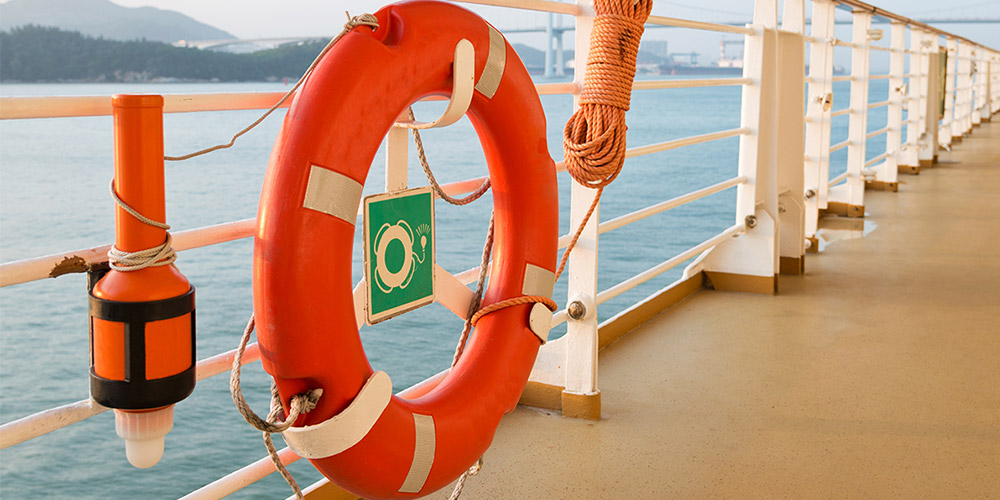Complete List of Life Saving Appliances Used on Ships

Personal Survival Systems
Every vessel’s first line of defense includes personal equipment designed for immediate emergencies. Life saving appliances on ships mandate:
- Immersion Suits: Insulated, waterproof suits (SOLAS-approved) extending survival time in hypothermic waters
- Lifejackets: Auto-inflating models (150N buoyancy) with integrated whistles and lights
- Thermal Protective Aids: Compact foil blankets retaining body heat during rescue waits
Abandon-Ship Deployment Systems
When evacuation becomes necessary, these critical life saving appliances on ship activate:
- Inflatable Life Rafts: Auto-deploying capsules (6-25 person capacity) with rain catchers and survival kits
- Davits & Launching Systems: Mechanical arms enabling single-person lifeboat deployment in <5 minutes
- Marine Evacuation Systems: Slipway chutes allowing 70-person/minute evacuation from high decks
Emergency Breathing Apparatus
For toxic environments or fire scenarios:
- Emergency Escape Breathing Devices (EEBDs): 10-minute oxygen supply hoods for escaping smoke-filled corridors
- Self-Contained Breathing Apparatus (SCBA): 30+ minute air tanks for firefighting teams (certified to EN 137 standards)
Detection & Alert Systems
Prevention-focused life saving appliances in India include:
- EPIRBs (Emergency Position Indicating Beacons): Satellite-linked distress signals with GPS coordinates
- SARTs (Search and Rescue Transponders): Radar-detected locators visible 8 nautical miles away
- Man-Overboard Systems: Crew-worn tags triggering deck alarms upon water immersion
Mass Rescue Equipment
Large-scale solutions for passenger vessels:
- Lifeboats: Totally enclosed, fireproof models with 24-hour air supply systems
- Rescue Boats: High-speed rigid inflatables for retrieval operations
- Muster Lists & PA Systems: Automated emergency instruction protocols
Maintenance & Compliance Essentials
Life saving appliances in India require rigorous upkeep per DG Shipping regulations:
- Monthly Drills: Functional testing of release mechanisms
- Annual Servicing: Hydrostatic testing of life rafts by certified facilities
- 5-Year Overhauls: Complete disassembly of lifeboat engines and davits
Why Standards Save Lives
India’s maritime safety framework demands SOLAS-compliance for all life saving appliances on ship. Recent incident data reveals:
| Equipment | Failure Cause | Prevention Protocol |
| Life Rafts | Canopy seam degradation | Bi-annual pressure testing |
| SCBA Masks | Cracked regulators | Quarterly negative pressure checks |
| Lifejackets | Faulty CO2 cylinders | Saltwater immersion simulations |
The Human Element
Behind every inflatable slide and EPIRB signal lies a critical truth: life saving appliances on ship only function when paired with:
- Crew certification (STCW training)
- Clear emergency protocols
- Cultural commitment to safety drills
A Mumbai-based study found vessels conducting monthly abandon-ship drills reduced evacuation time by 73% during actual emergencies.
Beyond Compliance: The Lifeline Ecosystem
Modern life saving appliances in India now integrate smart technologies:
- RFID-tagged lifejackets enabling headcount verification
- EEBDs with motion sensors alerting bridges when activated
- AI-powered EPIRBs predicting drift patterns for rescue coordination
Final Beacon: These meticulously engineered systems transform chaos into controlled survival. From the humble lifejacket light piercing monsoon darkness to satellite beacons guiding coast guard helicopters, every component represents humanity’s pact with those who sail into the unknown. Their silent vigilance is the ultimate warranty of safe passage.
Continuous innovation and strict adherence to SOLAS and DG Shipping standards ensure that life saving appliances in India remain effective and reliable. Regular crew training, updated muster lists, and technological upgrades are vital for operational readiness. Ultimately, the synergy between advanced equipment and well-prepared personnel is what truly safeguards lives at sea.




